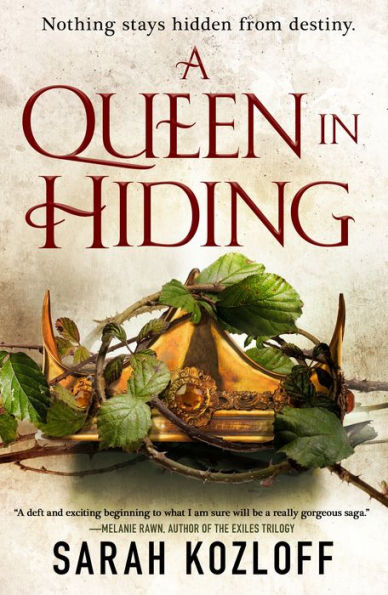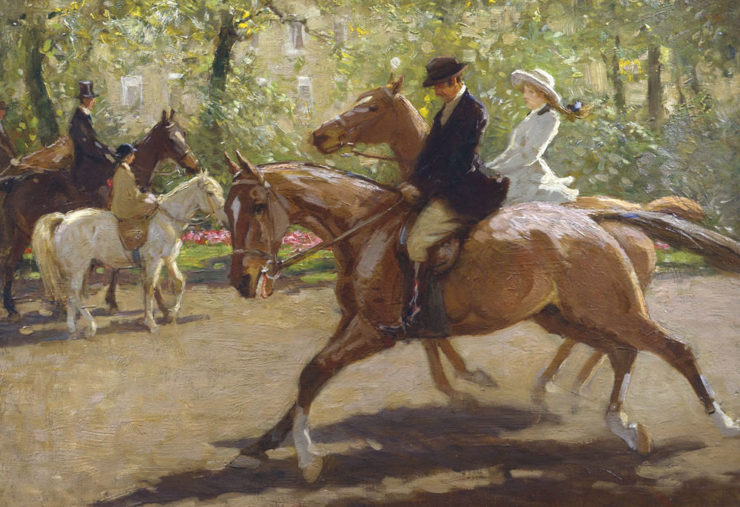If you want or need to write about a character riding a horse, or are a reader curious about what riding actually feels like, the best way to find out is to do it. But that isn’t always easy to make happen, and even if you do, there’s a big difference between a first ride and a hundredth or a thousandth. With riding, experience really does count.
There are some parallels with other and maybe more familiar sensations. Riding a bike or a motorcycle requires balance and attention to the details of steering and terrain. Driving a car or truck over rough roads asks some of the same things of your body as riding a horse will—staying in your seat, balancing as the vehicle shifts. Riding in a boat can give you some idea of what riding a horse is like: a really good canter is remarkably like navigating a series of waves, and a trot can remind you of a sharp chop on a lake.
But there’s another element that you only get from riding a horse or other large animal, and that’s the fact that you are sitting on a living and thinking being. That being has consented to let you do it—because if it hasn’t, you can force it up to a point, but past that point, it’s you versus an animal that can weigh somewhere around half a ton (and sometimes a fair bit more). In an all-out war, you’re not going to win.
Most of modern horse training has long since moved past the still too common myth of lassoing the wild colt, slamming a saddle on his back, and riding out the bucks till he’s properly “broken.” We “gentle” them now instead, take our time, get them used to the various equipment, gradually introduce the concept of being sat on and taught the signals for stop and go and turn and back up. If the horse is sound of body and mind, well raised and properly handled, he’ll be a willing participant in the process, will enjoy the chance to use his body and brain, and will look forward to his sessions.
Even horsepeople are known to observe that a horse would rather hang out in the pasture with his buddies than be ridden or worked. In my experience, that’s only true if there’s something awry with the work or the horse. I once lost a lease on a horse because his owner, who had a notoriously difficult time catching him in the pasture, saw him canter up to me and push his nose into the halter. It was a little too obvious at that point that the problem wasn’t the horse. (He ended up retired to pasture because the owner wouldn’t sell him and wouldn’t learn to ride him the way he needed to be ridden. At least he had a pleasant life.)
Buy the Book


A Queen in Hiding
In general, then, if you’re writing about the all-purpose fantasy riding horse, it’s fine to posit that the horse is properly trained and handled, and is inclined to cooperate with his rider. He’s familiar with the equipment, he stands quietly to be saddled, and he’s pretty likely to open his mouth for the bit if he’s ridden with one.
So here you are. The horse is ready. Maybe there’s a groom to do that, and to hold him for you, and even give you a leg up. Which means boosting you into the saddle—one common way is to hold out her linked hands at a little below your waist height; you put your foot in them, and hop while she boosts, and up you go.
How far up you go depends your height relative to the horse, which, best case, is not too disparate. You don’t want her to be so small your feet brush the ground when you’re on her, but if her back is more than a couple of inches higher than your head, you’ll seriously appreciate that leg up. Best height for mounting from the ground is preferably less than your own height, so that you can reach the stirrup without stretching too far.
I’ve managed a stirrup that was chin height or higher, when I was young and limber and the horse’s back was six or eight inches higher than my head. These days, and considering what it does to the horse’s back and withers when the weight of a rider pulls on them, I use a mounting block. Much easier on me, much easier on the horse.
Also, since with age comes prudence, I’ve been pleased to give my heart to smaller horses. Best size for my comfort is about nose height. The one who’s below chin height is deep in the barrel and high in the neck and fits me beautifully, though technically he’s a large pony.
There is the option of springing up from the ground, not touching the stirrup. For extra points, do it from behind, get a running start, bounce off the horse’s hindquarters, and land in the saddle. Which is very nice if you’re athletic. The rest of us do it the boring way.
Now you’re on, and you’re an experienced rider, so that’s been a nice, smooth process. Since you’re a modern USian rider, you’ve mounted on the left, reins gathered up in left hand, left hand on horse’s neck, right hand on rear of saddle. Left foot in stirrup, bounce, straighten left leg, raise body level with saddle. Right hand up, quickly swing right leg over saddle, land lightly in saddle. Right leg in stirrup, gather reins.
Horse has, throughout, stood still. We do not approve of horses who take off before the rider is settled in the saddle, though it’s all too common. Our horses stand until we tell them to move off. Your fantasy groom might hold the horse to make sure this happens, and release on your instruction.
You can take your time once you’re on. Get comfortable. Make sure your feet are properly seated in the stirrups—in our style of riding, balls of the feet resting on the stirrup, heels relaxed and down, legs draped down the horse’s sides.
This is your time to get the sense of how the horse is feeling, whether she’s calm and quiet or if she’s tense or on edge. Are her ears relaxed, maybe one or both tilted back to check in on you, or are they pricked forward and focused on something other than you? If they’re flat back and her back is coiled under you, that’s a bad sign—she’s pissed, and if she’s normally well trained and willing, that’s a signal to check and make sure there’s not something wrong with her or her equipment.
For our virtual ride, she’s fine. Relaxed. Happy ears. Waiting for the signal to move forward, prompt to respond to the light touch of your lower legs and release of the rein that says OK, We’re Good to Go.
Different horses move differently, but what they have in common is the combination of forward movement and movement from side to side. In the walk it’s a kind of gentle roll, and if you relax your back and open your hips and let the horse’s movement move you, to some degree it replicates your own walking motion. This is one of the benefits of therapeutic riding for humans with mobility issues, and it’s wonderful for teaching or reteaching balance in motion as well.
The trot (or jog) is very different. It’s one-two, up and down, and until you learn to ride with it, it’s horribly jouncy and bouncy and hard to sit. Modern riders will post the trot—let the upward bounce lift them, then come down in a steady rhythm, which once learned makes the trot much easier to cope with. Horses may be born with a smoother trot, and can be trained to smooth what they have, as riders can be trained to sit even a very elevated trot, but for the average rider, learning to post is a big help.
Canter (or lope) is another thing altogether. It’s a lot more work for the horse than walk or trot, but quite a bit less effort for the rider than the trot. It’s three beats, and a good canter will feel like riding a rocking chair. Ba-da-bum, ba-da-bum. It’s lovely and floaty, needs some core strength and educated balance, and really it’s the gait of dreams. That’s the one you see in soft-focus video footage, music swelling in the background, horse’s mane and tail and rider’s diaphanous draperies floating in the breeze.
Gallop is the fast one. Fast, fast, fast. Pounding hooves. Wind in your face. Mane whipping your fingers. One good leaping stride and you feel as if you could fly.
Every ride, good or bad, eventually comes to an end. Then your horse halts. You dismount in somewhat the reverse order of the mounting: reins in left hand, hand on neck or front of saddle, right hand beside it, right leg up, straight, over and down, then either pause with both legs level, left foot out of stirrup, drop lightly the rest of the way, or right leg to ground, left foot out of stirrup and down. Or you might kick your feet out of both stirrups and swing your right leg up and over and spring down.
And then the groom will take the horse and tend him, or you’ll do that yourself. Either way, there’s more to the ride than the riding, and the horse both needs and appreciates having his tack taken off, being walked around to cool him down if needed, groomed or rubbed down, maybe turned back out to pasture, or else led to his stall for dinner and a rest. You’ll get yours after he does, and be happy with that. Because that’s how a horse person is raised to be.
Judith Tarr is a lifelong horse person. She supports her habit by writing works of fantasy and science fiction as well as historical novels, many of which have been published as ebooks by Book View Cafe and Canelo Press. She’s even written a primer for writers who want to write about horses: Writing Horses: The Fine Art of Getting It Right. Her most recent novel, Dragons in the Earth, features a herd of magical horses, and her space opera, Forgotten Suns, features both terrestrial horses and an alien horselike species (and space whales!). She lives near Tucson, Arizona with a herd of Lipizzans, a clowder of cats, and a blue-eyed dog.










